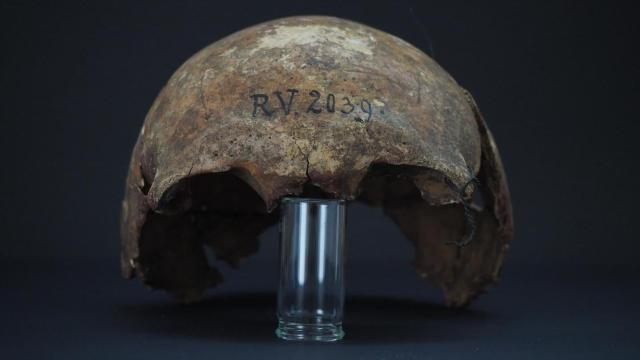The skull of a hunter-gatherer who lived in Europe over 5,000 years ago contains the oldest known traces of the bacteria responsible for causing the plague, according to a new study. The discovery is likely to yield some important clues as to the origins and evolution of this long-time germ foe, which has been responsible for some of the worst epidemics in human history.
Plague is caused by Yersinia pestis bacteria and is usually spread through contact with animals or from bites of fleas they carry; in this form, it’s known as bubonic plague. It also can become a very serious respiratory disease spread between people, known as pneumonic plague. The third, very rare, and often fatal form is called septicemic plague and happens when the bacteria reach the bloodstream.
Though now largely contained through better sanitation and the availability of antibiotics, in the middle ages, plague would regularly sweep through Europe, Asia, and Africa, leaving behind devastation in its wake. The Black Death in the mid-14th century is thought to be one of the most lethal pandemics ever, killing around a third of Europe’s entire population and at least 50 million people worldwide.
Just like every other living thing, the germs that cause human diseases evolve over time. Scientists have been deeply interested in unravelling when Y. pestis first encountered humanity and how it eventually changed into something capable of causing the Black Death. But the international team of researchers behind this new research say they weren’t even intending to find ancient plague where they did.
According to their study, published Tuesday in Cell Reports, they were simply looking for any DNA traces left behind in the skull remains of a young man buried approximately 5,000 to 5,300 years ago near the River Salaca in Latvia, close to a shell midden site called Rinnukalns (a place where humans left behind trash and evidence of their domestic life, particularly mollusk shells and animal bones). Luckily, this analysis included screening for potential pathogens, and that’s when they found bits of DNA coding for proteins known to be specific to Y. pestis. From these bits, they then reconstructed the genome of this strain, dubbed RV 2039 (the same designation given to the man) and compared what they found to other ancient strains that have been reconstructed.
The researchers say RV 2039 precedes any of these other samples of Y. pestis and may represent the beginnings of its evolution as a distinct species, albeit a lineage that went extinct. If their findings are valid, it could also change certain assumptions about how these bacteria existed back then.
“Our finding presents evidence of this bacterium in a hunter-gatherer and sheds more light on the very early phases of Y. pestis evolution and diversification,” they wrote.
Scientists firmly believe that Y. pestis split off from another species of bacteria called Yersinia pseudotuberculosis thousands of years ago, for instance. But the study authors argue their discovery could push the current estimated timeline of when this split occurred further back, to around 7,000 years ago. Furthermore, they say there’s evidence this version of plague was far tamer than the version behind the Black Death.
For one, like other ancient plague strains, these bacteria lack the adaptations that allowed them to spread from fleas, which is thought to have kickstarted their evolution into a more virulent disease. Because the DNA seems to have been recovered from the man’s bloodstream, though, it’s possible that he might have died from a deadly form of plague. But the sheer amount of plague DNA found suggests that the infection could have been tolerated without causing death, the researchers say, citing research showing that mice with high loads of modern plague bacteria tend to experience less disease.
In any case, the discovery of the man carefully buried alongside others with no plague suggests that, whatever he had, it wasn’t considered highly contagious by the human populations of that time. Combined with evidence from other ancient plague cases, the authors argue that this version may have not been capable of causing large outbreaks; instead, it only periodically infected people through bites from the many rodents that serve as its natural hosts. If true, that would put a serious dent in a recent theory that the early emergence of pneumonic plague caused a widespread pandemic around then, fuelled by trade routes between Neolithic settlements.
“’[B]ased on the genomic data, it cannot be excluded that RV 2039 and the other early forms were less transmissible than the later strains, leading only to local outbreaks,” they wrote.
It’s likely that this debate about ancient plague won’t be settled by a single study. But its findings are incredible for another reason, the researchers say.
The burial site and skull were actually first discovered in the late 19th century by the amateur archaeologist Carl Georg Count Sievers. Sievers and his mentor, the German doctor Rudolf Virchow, argued that the site had to be prehistoric, but their theory was roundly criticised by others of the time. Eventually, the man’s skull seemingly vanished after World War II but was rediscovered in the collections of Virchow’s work maintained by the Berlin Society for Anthropology, Ethnology, and Prehistory in 2011; subsequent carbon dating then confirmed its old age, vindicating Sievers and Virchow.
“Virchow was in no position to diagnose plague with the Rinnukalns cranium. However, thanks to Virchow’s progressive scientific approach, the remains excavated by Sievers were stored in his collection, where they survived the vicissitudes of time unscathed, so that a later diagnosis was still possible, even after 145 years,” the study authors wrote.
